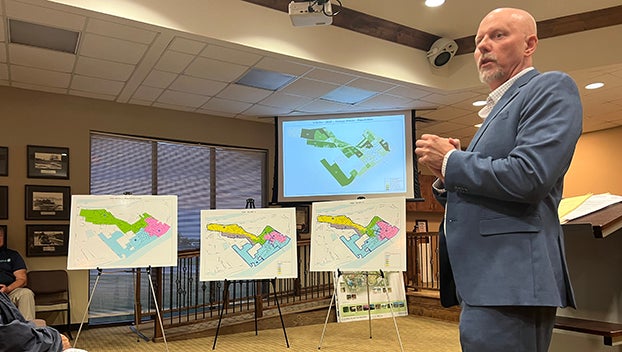REDISTRICTING: Vidalia Aldermen to consider approval of 5 districts instead of 3
Published 7:34 pm Wednesday, October 12, 2022

- William Blair of Strategic Demographics presents two proposals for new Vidalia districts. (File photo | The Natchez Democrat)
|
Getting your Trinity Audio player ready...
|
VIDALIA, La. — Two proposals for where new district lines could be drawn were presented at Tuesday’s meeting of the Vidalia Mayor and Board of Aldermen.
These maps look very different from the original three districts in the Town of Vidalia because they each outline five districts with approximately 800 voters in each.
Currently, Vidalia currently has three districts and five aldermen representing the three districts. District 3—which has the largest voting population—is represented by three aldermen who get the top three most votes from everyone in the district. Click here to view a map of the original districts and two proposals for new districts.
All members of the Board of Aldermen present at Tuesday’s meeting agreed with having five districts. However, one alderman, Robert Gardner, said he was not “confident” in the mapping of the new districts presented by Strategic Demographics, the redistricting firm hired by the town.
The first proposal (Map A) extends District 1 to the Southeast along Vidalia Levee Road to N. Magnolia Street. District 2, Gardner’s district, loses those streets to District 1, represented by Rosa Demby, but gains the area Northeast of U.S. 84 from North Hickory Street to Cross Street.
In the second proposal (Map B) instead of extending District 1 along the Vidalia Levee Road, District 1 takes in some of the areas between Oak, Hickory and Spruce streets and Cross Street to N. Oak Street. District 2 loses Oak Street to District 1 but gains territory North of Vidalia Levee Road to S. Spruce Street and John Dale Drive to Vidal Street and also gains a block from Holly Street to Elm Street between Concordia Avenue and Alabama Street.
The proposals for Districts 4 and 5 are the same for both maps. District 5 takes up the North end of the town from U.S. 84 to Vidalia Levee Road and stops at Camellia, Peach and Lynn streets.
District 4 starts South of U.S. 84 and stops at Myrtle and Plum streets. District 3 will start South of Peach and Lynn streets and the Vidalia Canal and end either at Cedar, Cross and Willow streets (Map A) or end at Sycamore, Cross and Elm streets and share part of Maple, Pine and Hickory streets with District 1 (Map B).
Vidalia Mayor Buz Craft said Map A was created by Strategic Demographics without any input from the aldermen while Map B was proposed with Gardner’s recommendations.
Alderwoman Demby was absent from Tuesday’s meeting, but all of the other aldermen expressed their satisfaction with Map A except for Gardner.
“I’m not 100 percent satisfied,” he said. “I support keeping the five districts but feel that we need more time to review them because they could potentially affect us for the next 10 years or even longer. On the old map, I did not have Texas Street or Pecan and Map A gave me Texas Street and Pecan and Map B gave those to District 1. I feel like they should go back to one of the three members of the largest district.”
Gardner said he was concerned about the number of minority voters in the district dwindling with both of the new proposals. Map A drops the minority voters in District 1 from 75 percent to 62 percent and Map B, and “the plan that I helped with” dropped the percentage of minority voters even further to 58 percent, Gardner said.
Federal and state law requires municipalities to redistrict after every decennial census if there is an uneven distribution of voters in each district by more than a 5 percent margin. The law also requires minority groups or groups with common interests to be undivided.
Vidalia has no elections until 2024, but the redistricting must be done by Dec. 31, 2022. Not doing so is punishable with malfeasance in office charges, William Blair, Ph.D., of Strategic Demographics said.
The 2020 Decennial Census determined that District 1, a minority district, has a variance of 20 percent, or 160 fewer people than it should, Blair said. District 2 has a variance of 12 percent fewer people and District 3 has a variance of 10 percent too many people.
To correct that, both Districts 1 and 2 have to gain people and District 3 has to lose people, Blair said. With Vidalia having a majority African American population in District 1, that leaves the town with limited options, he said.
“I understand that there is a timeframe, but I ask that we not rush the approval of the map,” Gardner said. “We have until December to make I final decision.”
Craft said he feels no Alderman should be able “to pick and choose whom they represent.”
Craft said the aldermen would vote on the new district maps at the next regularly scheduled board meeting, which is Nov. 8.





